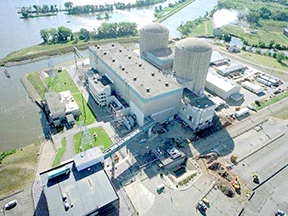
Sandia and the US Nuclear Regulatory Commission (NRC) have enjoyed a long and productive relationship. Today, with a resurgence of interest in nuclear power around the nation, that relationship is poised to become closer than ever, with Sandia supporting the NRC in its regulatory capacity in licensing new US nuclear power plants.
Sandia has supported various NRC offices (Research, Reactor Regulation, etc.) primarily in safety and security research. The Labs’ work has provided vital insights that have helped the NRC develop appropriate rules and regulations for nuclear power plants. In addition, Sandia is now serving as the lead lab for DOE as it seeks certification from the NRC to operate Yucca Mountain as a nuclear waste repository.
Under its new role with NRC, Sandia will be part of an extended team of national labs and private-sector contractors directly involved with NRC’s Office of New Reactors (NRO). They will be involved in certifying new nuclear power plant designs and reviewing license applications for construction and operation. The NRC is funding Sandia’s work at up to $25 million or 60 FTEs over a period of five years, with a possibility of more funding and more work in the future.
According to Tim Wheeler (6764), principal investigator in Sandia’s work with NRO, the NRC anticipates that over the next three years it will receive as many as 18 applications for new nuclear power plants (up to 30 new reactors) — either for design certification or for a combined license, which authorizes construction and conditional operation.
That “tsunami of applications,” as Tim calls it, comes after decades of near-dormancy in the industry. Since the 1979 Three Mile Island accident, no US nuclear power plant had been authorized to begin construction. Several plants were already in the construction phase at the time and have subsequently come on line after often protracted legal and political challenges.
Much has changed in the political climate, in the climate of public opinion — and, indeed, in the climate itself — since 1979. In recent years, utilities have again decided that nuclear power is a good bet and are jumping in. And the NRC, sensitive to criticisms going back decades that its licensing process took too long, has pledged to handle this new generation of license applications more expeditiously, says Felicia Durán, a key member of the Sandia team working with the NRC.
The renewed interest from industry and investors toward nuclear power got a significant boost with the passage of the Energy Policy Act of 2005, which was signed by President George W. Bush at Sandia in August 2005. That act, championed by Sen. Pete Domenici, R-N.M., and Sen. Jeff Bingaman, D-N.M., includes provisions making nuclear power a more viable option for utility companies than it has been in decades.
NRC’s Office of New Reactors provides a solid regulatory framework to deal with the flood of new applications, says Felicia. NRC has substantially ramped up its own hiring program and is teaming with several national laboratories and some private-sector contractors to facilitate the licensing process. The national labs working with NRC are valued both for their technical competence and because they bring no conflicts of interest to the table, says Felicia.
Each license application is a complex, multifaceted document that spells out in meticulous detail the technical, environmental, and safety aspects of the applicant’s proposal. Each aspect of the application — there are 230 subsections in a typical application, and each will require a technical review — must be evaluated against the standards established by NRC. Currently, Sandia will be supporting two branches of the NRO that together account for 41 distinct review activities. These areas fall under the general heading of “balance of plant,” which encompasses virtually everything but the reactor and its related systems, the nuclear steam supply system, and the emergency core cooling system. Sandia also expects to play a significant role in reviewing these critical systems as NRO’s requirements evolve. Sandia is in discussion with other NRO branches to support additional review activities.
Sandia, Tim notes, brings a broad suite of capabilities to its work with NRC, as well as an unparalleled reputation for delivering impeccable research. The work for NRC, he adds, is a good match for Sandia, advancing as it does a new generation of nuclear power facilities around the country. Those facilities, in turn, advance the nation’s energy security, which is a key element of Sandia’s national security mission.
Tim says his biggest immediate challenge will be assembling a team of Sandians from a broad range of disciplines from metallurgy, geology, and fire safety to human factors, structural analysis, and health physics. Tim says he plans to aggressively seek qualified personnel from throughout the Labs to join the Sandia effort, adding that a number of Sandians who have worked on NRC projects in the past but have moved to other positions are contacting him saying they want to get back on the team.
That doesn’t surprise Tim. “For a lot of us who have worked in nuclear power over the years,” he says, “this is a chance to be in on the ground floor of a new era.”